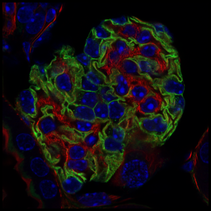Microscopy
Confocal MicroscopesLighthouse currently operates several spectral confocal microscopes:
Zeiss LSM 710 confocal (Lighthouse - ZTZ)
Zeiss LSM 880 with AiryScan Fast confocal (Lighthouse - ZTZ)
Zeiss LSM 980 NLO (Multiphoton) with AiryScan2 confocal (IMITATE - BiMiC)
Zeiss Celldiscoverer 7 with LSM 900 and AiryScan2 confocal / widefield (IMITATE - BiMiC)
Zeiss Lightsheet 7 lightsheet microscope (IMITATE - BiMiC)
Confocal microscopes can take images in which only the focal plane of a sample is visible. This results in an improved signal-to-noise ratio, as well as an increase in effective resolution relative to those made with a standard fluorescence microscope. Confocal microscopy is of potential interest in a wide range of experiments, for example those involving thick specimens, intracellular studies, and colocalization, as well as in studies where the three-dimensional structure of the sample is important.
The confocal microscopes are all spectral systems. The systems with AiryScan are high resolution microscopes able to take images of specimens beyond the diffraction limit. Each of the microscopes is equipped with climate control chambers for live cell imaging/timelapse measurements.
The laser wavelengths available on the different systems are listed in the table below.
| Laser Wavelength(s) | Examples of Dyes or Proteins Which Can Be Used |
| 405nm | DAPI, Alexa 405, Pacific Blue, Brilliant Violets (BV421, etc.) |
445/458 nm** 488 nm 514 nm** | eCFP, Helix Blue, SYTOX Blue Alexa Fluor 488, FITC, CY2, eGFP eYFP |
| 561 nm | CY3, TRITC, AlexaFluor 568, DsRed, mCherry, PE* |
| 633/638 nm | CY5, Alexa 633 / 647, SirDNA, DRAQ-5, DRAQ-7, APC* |
*Note: If you decide to use phycobiliproteins (PE, APC) to label your samples, we recommend the use of glycerol-free mounting media such as FluoSave to minimize bleaching.
** 445/458 nm and 514 nm are available only on the LSM 710, LSM 880 and LSM 980 systems.
The LSM 980 NLO (multiphoton) is equipped with a Coherent Chameleon 2 photon laser for examination of thicker specimens or for experiments requiring photoablation.
The Lightsheet 7 is equipped with 4 lasers (405 nm, 488 nm, 561 nm, 638 nm). Lightsheet microscopes also allow optical sectioning of samples, but are optimized for looking at much thicker specimens, at lower resolution than a confocal microscope.
The CellDiscoverer 7 (CD7) is an automated microscope which can be used for screening projects as well as for standard imaging. It is possible to use it in widefield or confocal mode and is particularly good at examining samples in microtiter plates (96- or 384-well), but can also be used for examining samples on slides or dishes. It has a fully integrated climate control system and is well-suited for live cell imaging.
Only those investigators who have been previously trained to use the microscopes by the Lighthouse staff will be allowed to use them on their own, otherwise it is necessary for a member of the Core Facility to assist you. For information about reserving time on the instruments, just contact the facility.
Separate computer workstations are available in the ZTZ and in the IMITATE building with a number of image analysis programs (3D reconstruction, deconvolution, high content analysis) that you can use. For open source software to help you with examination of your images please see our confocal links of interest page below.
Live Cell Imaging with Zeiss CD7

